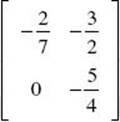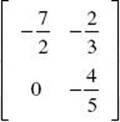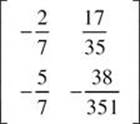SAT SUBJECT TEST MATH LEVEL 2
PART 2
![]()
REVIEW OF MAJOR TOPICS
![]()
CHAPTER 3
Numbers and Operations

3.3 Matrices
![]()
DETERMINANTS AND INVERSES OF SQUARE MATRICES
The determinant of an n by n square matrix is a number. The determinant of the 2 by 2 matrix  is denoted by
is denoted by  , which equals ad – bc.
, which equals ad – bc.
EXAMPLES
1. Write an expression for the determinant of  .
.
By definition,  .
.
2. Solve for x: 
The determinant on the left side is x2 – 8x. Use the calculator to evaluate the determinant on the right as 9. This yields the quadratic equation x2 – 8x – 9 = 0. This can be solved by factoring to get x = 9 or x = –1.
For larger square matrices, use the graphing calculator to calculate the determinant (2nd/MATRIX/MATH/det). A matrix whose determinant is zero is called singular. If the determinant is not zero, the matrix is nonsingular.
The product of square n by n matrices is a square n by n matrix. An identity matrix I is a square matrix consisting of 1”s down the main diagonal and 0”s elsewhere. The product of n by n square matrices I and A is A. In other words, I is a multiplicative identity for matrix multiplication.
A nonsingular square n by n matrix A has a multiplicative inverse, A–1, where A–1A = AA–1 = I. A–1 can be found on the graphing calculator by entering MATRIX/NAMES/A, which will return A to the home screen, followed by x–1 and ENTER.
3. If  and
and  , solve for X when AX = B.
, solve for X when AX = B.
Matrix multiply both sides on the left by A–1:A–1AX = A–1B. This yields IX = X = A–1B = ![]() . The fractional form of the answer can be obtained by keying MATH/ENTER/ENTER.
. The fractional form of the answer can be obtained by keying MATH/ENTER/ENTER.
EXERCISES
1. The determinant of  is
is
(A) p – 6
(B) p + 6
(C) 3p – 2
(D) 3 – 2p
(E) –6 – p
2. Find all values of x for which  .
.
(A) ±3.78
(B) ±4.47
(C) ±5.12
(D) ±6.19
(E) ±6.97
3. If  , then X =
, then X =
(A) 
(B) 
(C) 
(D) 
(E) undefined